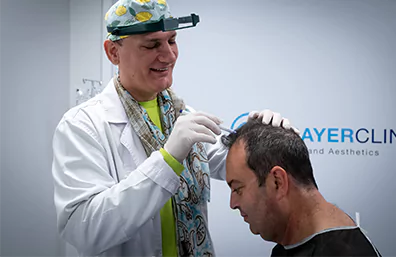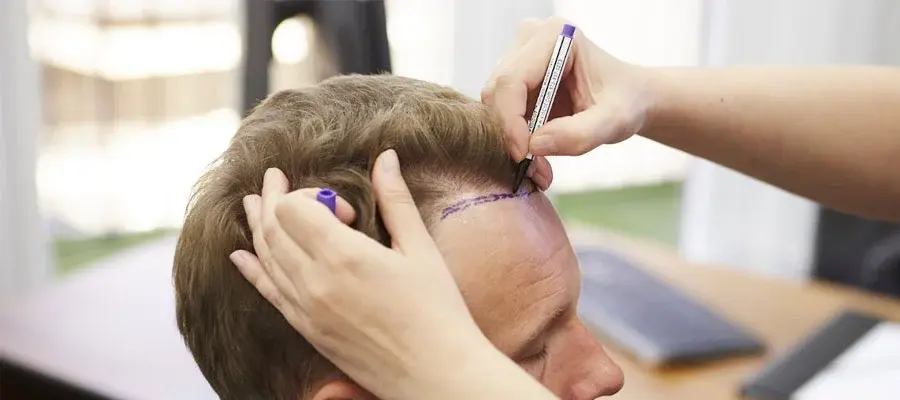Costs for hair transplant turkey procedures typically fall between $2,000 and $6,000 USD. This range reflects the number of grafts required—most patients receive 2,000 to 3,000 grafts in a single session—and the technology involved, such as Follicular Unit Extraction (FUE) or Direct Hair Implantation (DHI), which preserves graft viability and promotes natural-looking density.
Per-graft pricing usually starts at around $2.40 USD, meaning a 2,500-graft treatment would amount to approximately $6,000 USD. By calculating your individual graft needs during a complimentary consultation, you receive a clear, itemized quote without unexpected add-ons. This transparency helps you plan your budget and ensures you know exactly what you’re investing in.
Our all-inclusive hair transplant turkey package covers airport transfers, three nights of hotel accommodation, prescribed medications, and the first post-operative wash performed by experienced assistants. Including these services in the overall cost allows you to focus on recovery rather than logistics, smoothing your journey from arrival through follow-up care.
How is Hair Transplant Done in Turkey?
A hair transplant Turkey is performed by extracting healthy follicular units from the donor area—usually the back or sides of the scalp—and implanting them into thinning or bald regions under local anesthesia. This method begins with a detailed scalp assessment and mapping of graft placement to ensure that the new hairline harmonizes with your facial features.
After numbing the donor zone, surgeons use Follicular Unit Extraction (FUE) or Direct Hair Implantation (DHI) tools to remove individual grafts with minimal trauma. Each follicle is then carefully prepared under magnification to preserve its integrity. Implantation follows, with grafts placed at precise angles and depths to mimic natural growth patterns and achieve an even density.
Throughout the procedure, specialized instruments—such as motorized punches or sapphire-tipped implanters—help maintain graft viability and reduce post-operative swelling.

Hair Transplant Methods Offered in Turkey
Clinics in Turkey commonly offer Follicular Unit Extraction (FUE) and Direct Hair Implantation (DHI) as their primary hair transplant methods. These techniques are favored because they balance effective graft survival with minimal discomfort and downtime, making them well-suited to a wide range of hair loss patterns.
If you’re considering a hair transplant Turkey and want to explore which method aligns with your goals, our team is ready to guide you through a personalized evaluation. Book your free consultation today to learn more about the techniques and plan your path to renewed hair confidence!
The Typical Process For An International Patient
The typical process for an international patient begins with a remote consultation to assess hair loss patterns and plan graft requirements. During this online meeting, high-resolution photos or a short video of your scalp help the surgical team determine the appropriate technique—such as FUE or DHI—and estimate the number of grafts needed. This early alignment ensures that travel arrangements and treatment dates are set with clear expectations, minimizing surprises on arrival.
Once you arrive in Turkey, airport pickup and a brief in-person evaluation confirm the details discussed remotely. Local anesthesia is administered on the day of surgery, and follicular units are harvested from the donor zone before being implanted into thinning areas. The coordinated care of nursing staff and surgical assistants ensures that grafts are handled under magnification, preserving follicle health and supporting a natural hairline design that complements your facial features.
After the procedure, you remain in country for two to three nights to allow for your first post-operative wash and early recovery monitoring. Gentle scalp care instructions, prescribed medications, and sun-avoidance guidelines are reviewed in detail before departure.
How Turkey Combines Affordability and High-Quality Medical Care
In Turkey, hair transplant procedures can be more cost-effective than in many other countries without reducing adherence to clinical standards. Operating expenses—such as facility rent, staffing and equipment costs—tend to be lower, and clinics often provide bundled packages that include accommodation, airport transfers and post-operative care. This pricing structure helps patients plan their budget up front, without encountering hidden fees after arrival.
Regulatory oversight and international certifications (for example, ISO and Joint Commission International) set clear requirements for hygiene, staff qualifications and facility safety.
How is the Number of Grafts Determined in Hair Transplant?
Determining the number of grafts for a hair transplant turkey procedure involves assessing the size of the thinning area, the patient’s desired density, and the reserve of donor hair. During an initial evaluation, the surgeon measures the bald or thinning zones—often using photographic analysis and scalp mapping—to calculate how many follicular units are required per square centimeter to achieve a natural look. This measurement ensures that coverage is neither too sparse nor overly dense, striking a balance that harmonizes with existing hair.
Patient expectations play a central role in graft calculation because different individuals seek varying degrees of fullness. By discussing aesthetic goals and reviewing before-and-after simulations, the surgical team can translate “light thinning” or “advanced recession” into a specific graft count. This tailored approach guarantees that the final outcome matches the patient’s vision without compromising donor area integrity.
How Duch Does a Hair Transplant Cost Turkey in 2025?
While both FUE and DHI begin with the careful extraction of individual follicular units, FUE implants grafts into pre-made recipient slits, streamlining the implantation phase. In contrast, DHI’s direct implantation method minimizes graft handling and can improve survival rates, but the coordinated, hand-held technique extends the duration of surgery. Clinics account for these factors in their pricing, reflecting the balance between efficiency and the finer control that DHI offers.
FAQs About Hair Transplant
Are Hair Transplant Results Permanent?
Yes, hair transplant results are considered permanent because transplanted follicles are drawn from areas genetically resistant to hair loss and continue growing in their new location. Although surrounding, non-transplanted hairs may continue to thin over the years, the grafted units themselves do not fall out due to pattern baldness. Proper post-procedure care—such as gentle scalp hygiene, sun protection and adherence to any prescribed topical treatments—supports strong graft integration and long-term growth. By anchoring new follicles in stable zones and supporting scalp health, a hair transplant delivers enduring density and a natural appearance.
Is There a Lot of Blood Loss During Hair Transplant?
No, patients typically experience minimal blood loss during a hair transplant procedure. Local anesthesia combined with a tumescent solution—often containing a mild vasoconstrictor—numbs the scalp and constricts small blood vessels, so only tiny amounts of blood seep from each micro-incision.
Because follicular units are harvested and implanted through millimeter-scale punctures rather than large cuts, bleeding is limited and immediately controlled with gentle pressure. Throughout the session, surgical assistants apply sterile gauze and, if needed, topical hemostatic agents to keep the field clear and maintain visibility.
After the procedure, any light oozing around the graft sites typically stops within a few hours, and patients can resume normal activities without worrying about significant bruising or blood loss.
Post-Hair Transplant Process Management
Post-hair transplant process management is a structured aftercare routine designed to protect newly implanted follicles and support healthy scalp healing. By following clear guidelines immediately after your procedure, you give grafts the best chance to establish a robust blood supply and anchor securely in their new locations.
As healing progresses over the first few weeks, lifestyle adjustments play a key role in long-term success. Steering clear of intense exercise, saunas or sun exposure protects the sensitive scalp, while resisting the urge to scratch or pick at crusts preserves graft integrity. Maintaining a balanced diet rich in protein, vitamins and adequate hydration supports tissue repair, and scheduled follow-up visits allow your care team to monitor progress and address any concerns—so that by the nine- to twelve-month mark, you can enjoy the full, natural results of your hair transplant.
Does Shock Loss Occur After Hair Transplant?
Yes, a temporary shedding phase called shock loss can occur after a hair transplant. This happens because the trauma of follicle extraction and implantation can push existing hairs into a resting (telogen) phase, causing them to fall out alongside or around transplanted grafts.
Although alarming at first, shock loss is usually a short-lived reaction: dormant follicles shed their shafts before restarting a new growth cycle. Within three to four months, most patients begin to see fresh, stronger hairs emerge as grafted and remaining follicles enter the active (anagen) stage. Maintaining gentle scalp care and following post-operative guidelines helps minimize excessive shedding and supports a smoother transition from shock loss to visible regrowth.
How to Treat Donor Area Burning After Hair Transplant?
Donor area burning after a hair transplant can be eased through gentle cooling measures, targeted anti‐inflammatory care, and attentive scalp hygiene. This burning sensation often stems from local anesthesia, the tumescent solution used during extraction, and minor nerve irritation as the scalp begins its healing process.
Applying a cool, damp compress to the donor region for brief intervals helps constrict superficial blood vessels and reduce inflammation, making the area feel more comfortable. At the same time, taking prescribed anti‐inflammatory medication as directed helps control swelling and soothes nerve endings. It’s important to avoid scratching or rubbing the site, since mechanical irritation can prolong discomfort and interfere with normal healing.
Shampoo Usage After Hair Transplant
You can safely begin gentle shampooing about 48 hours after your hair transplant. This initial delay gives newly implanted grafts time to anchor and form tiny scabs without the risk of dislodgement.
When you start washing, choose a mild, pH-balanced shampoo free of sulfates or harsh detergents. Such formulas cleanse away dried blood and sebum without irritating the scalp or stripping moisture, helping to keep grafts healthy as they establish a secure blood supply.
To rinse, use lukewarm water poured gently over the treated area—avoid high-pressure jets or direct streams. Apply shampoo with your fingertips in light, tapping motions rather than vigorous rubbing. This technique loosens crusts and debris without disturbing the delicate follicles.
Will There Be Edema After Hair Transplant?
Yes, mild facial edema commonly develops following a hair transplant procedure. This swelling occurs because local anesthesia and tumescent fluid infiltrate the scalp’s donor and recipient zones, causing temporary fluid accumulation in surrounding tissues. Even though individual follicular units are extracted and implanted through tiny punctures, the body’s natural reaction to the minor trauma includes increased capillary permeability and fluid retention.
Edema typically becomes most noticeable around the second or third day after surgery, often affecting the forehead, temples, and sometimes the area around the eyes. As inflammatory mediators subside and the lymphatic system clears excess fluid, swelling gradually diminishes—most patients see a significant reduction by the end of the first week and near‐complete resolution within ten days. During this period, keeping the head elevated when resting and applying gentle, cool compresses can help accelerate fluid drainage and improve comfort.

